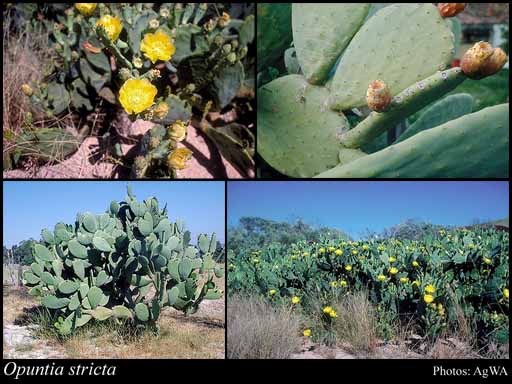- Reference
- Syn.Pl.Succ. 191 (1812)
- Conservation Code
- Not threatened
- Naturalised Status
- Alien to Western Australia
- Name Status
- Current
Spreading to erect shrub, to 2 m high. Fl. yellow. Sandy soils.







Distribution
- IBRA Regions
- Coolgardie, Geraldton Sandplains, Mallee, Murchison, Pilbara, Swan Coastal Plain.
- IBRA Subregions
- Chichester, Eastern Goldfield, Eastern Mallee, Eastern Murchison, Geraldton Hills, Perth, Roebourne, Southern Cross, Western Murchison.
- IMCRA Regions
- Abrolhos Islands.
- Local Government Areas (LGAs)
- Cue, Dundas, East Pilbara, Esperance, Greater Geraldton, Kalamunda, Karratha, Leonora, Meekatharra, Yilgarn.
Management Notes (for the Swan NRM Region)
Alternative Names. Opuntia spp..
General Biology. Growth form. Shrub/Small Tree. Life form. Perennial. Reproduction. Asexually from stem fragments, flowers or immature fruits.. Dispersal. Local dispersal around existing clumps occurs when segments or fruit drop to the ground and take root. The plant fragments can be dispersed in flood waters or by native animals and stock.. Time of first flowering. Third year. Type of stem. Succulent. Seedbank persistence. 10 to 20 years.. Fire response. May not be killed in fire, may result in vigorous regrowth following fire. Very small plants and seeds will be destroyed in the hot fire..
Notes. These species are shrubs or small trees with jointed, succulent stems (pads) that are cylindrical, club-shaped or compressed. The areoles (spots on the stem segments) are tufted with barbed bristles (glochids) and with usually 1 or more stout spines. The leaves are mostly scale-like and conical to cylindrical (terete) in shape. The solitary and stalkless (sessile) flowers are produced on the areoles. The petals of Opuntia species found in Australia vary in colour from yellow, orange, red to purple. The fruits bear areoles, sometimes with spines. The seeds are disc-shaped (discoid) or irregularly shaped..
Additional information. Origin. Prickly Pears occur naturally throughout North and South America.. History of use/introduction. Prickly Pear species were brought to Australia on the First Fleet with the intention of establishing a cochineal industry as these species are hosts for the cochineal insects. Opuntia species are cultivated as ornamental, hedge or food plants.. Similar exotic species. Opuntia ficus-indica. Similar native species. Austrocylindropuntia, Opuntia, Cylindropuntia spp..
Suggested method of management and control. Physical removal appears to be one of the most effective control methods for Prickly Pears, but the spines make manual removal of these species difficult. Care must also be taken to remove and properly dispose of, usually by burning, all vegetative and fruit material. The root system must also be dug out to prevent regrowth. While several herbicides are recommended for managing Prickly Pears, chemical control is not always effective as many species occur on rocky slopes, and infested areas must be checked and resprayed over several years if necessary. Biological control using Cactoblastis moths or Cochineal insects can be effective on dense populations, and outlying plants can be infected by transferring infected pads to them. However, there are a number of species of Cochineal insects that are host specific and may destroy one species of Opuntia but not others. The effect of these agents appears to be limited in colder climates. Read the manufacturers' labels and material safety data sheets before using herbicides. For further information consult the Australian Pesticides and Veterinary Medicines Authority to determine the status of permits for your situation or state.
Management Calendar
| Calendar Type | Jan | Feb | Mar | Apr | May | Jun | Jul | Aug | Sep | Oct | Nov | Dec | Comments |
|---|---|---|---|---|---|---|---|---|---|---|---|---|---|
| Germination | O | O | O | O | O | O | O | O | O | O | O | O | Under suitable condition |
| Flowering | Y | Y | O | O | O | Y | Y | Y | |||||
| Fruiting | Y | Y | Y | Y | O | O | Y |
Legend: Y = Yes, regularly, O = Occasionally, U = Uncertain, referred by others but not confirmed.
References
- Department of Primary Industries and Regional Development (2017) Cactus Month 2017. Department of Primary Industries and Regional Development URL: https://www.agric.wa.gov.au/invasive-species/cactus-month-2017?page=0%2C1 - Accessed June 2019.
- Department of Primary Industries and Regional Development (2018) Opuntioid cactus: declared pests. Department of Primary Industries and Regional Development URL: https://www.agric.wa.gov.au/declared-plants/opuntioid-cacti-declared-pests - Accessed June 2019.
- Parsons, W.T. & Cuthbertson, E.G. (2001) Noxious weeds of Australia. 2nd Edition. CSIRO Publishing, Collingwood.
- Sheehan, M. R. & Potter, S. (2017) Managing Opuntioid Cacti in Australia: Best practice control manual for Austrocylindropuntia, Cylindropuntia and Opuntia species.. Department of Primary Industries and Regional Development, Perth.
- Vermeire, L. T. & Roth A. D. (2011) Plains Prickly Pear Response to Fire: Effects of Fuel Load, Heat, Fire Weather, and Donor Site Soil. Rangeland Ecol Manage, 64: 404-413.